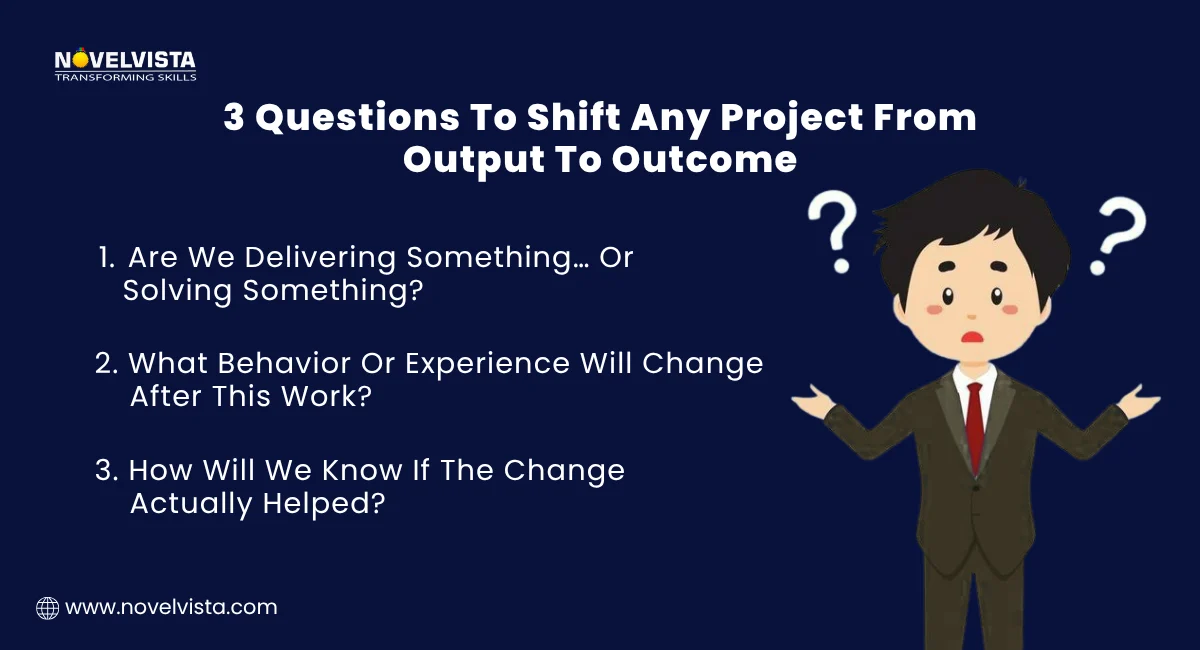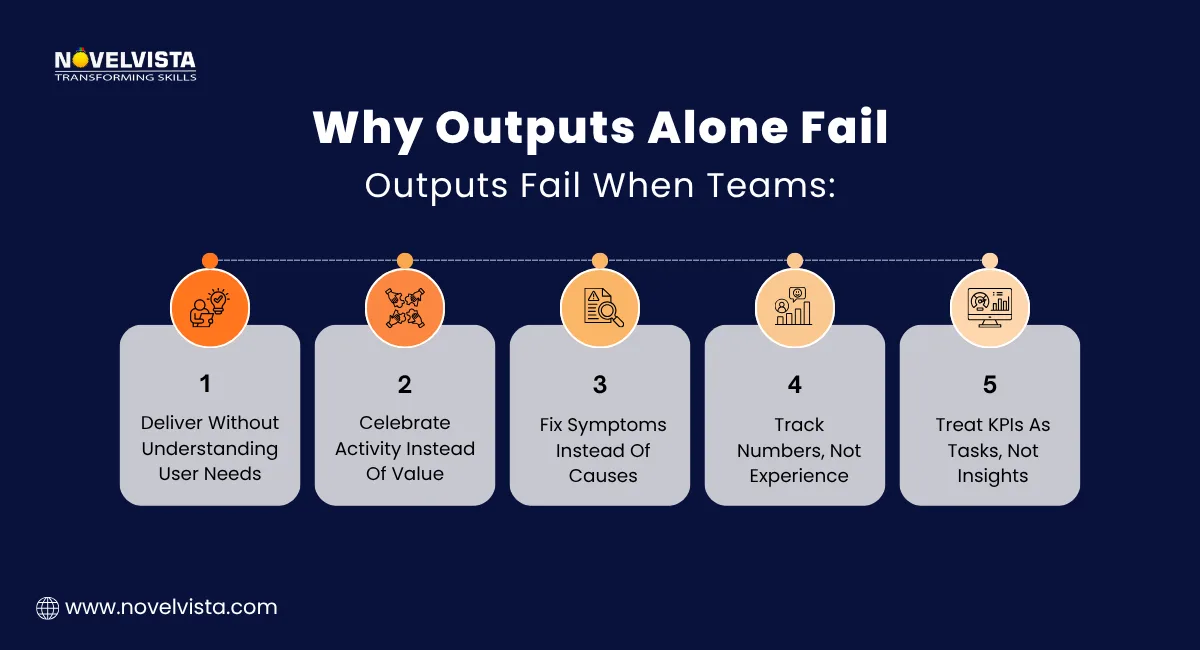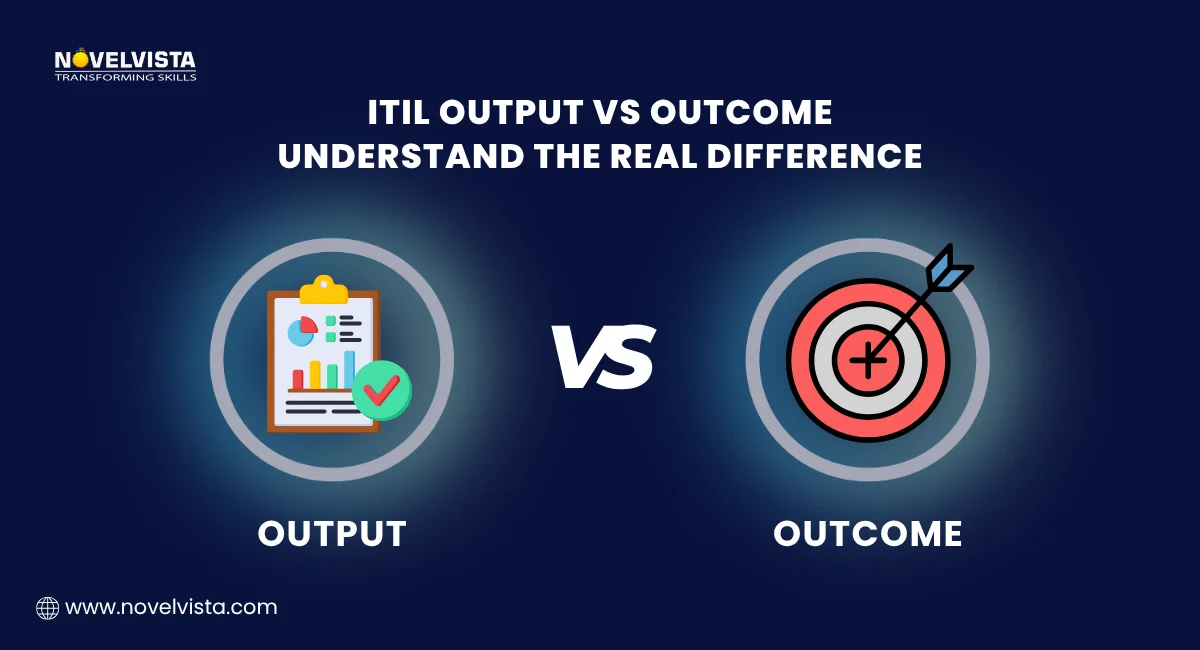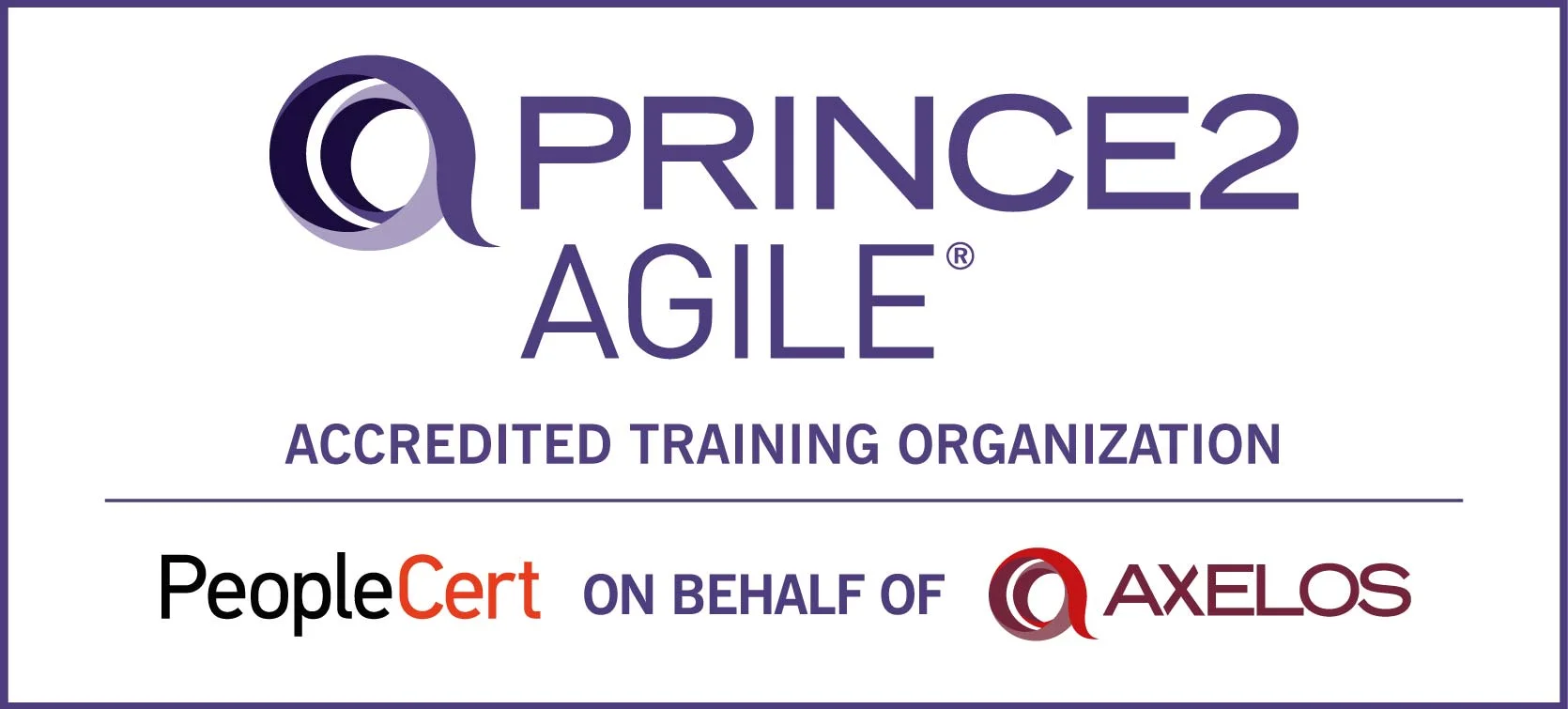- What Output Means in ITIL (Simple Breakdown)
- What Outcome Means in ITIL (Clear Definition)
- Differentiator Table: Output vs Outcome vs Impact
- Output vs Outcome vs Impact Explained
- Outcome vs Output Examples for Easy Understanding
- Why Focusing on Outcomes Creates Better IT Services
- How to Measure Outputs vs Outcomes Effectively
- Common Challenges in Measuring Outcomes and Delivering Real Value
- How ITIL 4 Guides Teams on Output vs Outcome
- Conclusion:
Let’s start with something most teams never admit out loud: they celebrate tasks being marked “done,” yet no one checks whether anything actually improved. This is where ITIL Output vs Outcome becomes such a big deal. Many teams finish activities, close tickets, push changes, and still wonder why users don’t feel the benefit.
So here’s the simple difference upfront:
Output is what you deliver. The outcome is what the delivery changes.
This blog walks you through the ITIL Output vs Outcome difference in a way that clears the confusion and helps you focus on value instead of activity.
What Output Means in ITIL (Simple Breakdown)
An output is the direct thing you produce from a task or process. It’s something you can point at and say, “Yes, this is done.” When we talk about ITIL Output vs Outcome, outputs sit on the activity side. They show effort, structure, and completion.
Some simple examples:
- A change request is documented
- A software patch is deployed
- A knowledge article is published
- A server is configured
- A report is generated
All of these are outputs. They are useful, but they don’t guarantee improvement. That’s why the ITIL Output vs Outcome comparison matters so much. Many teams focus heavily on finishing outputs and forget to check whether stakeholders gained any real benefit.
Outputs help you track progress, but they don’t confirm value. And that’s where outcome thinking comes in.
What Outcome Means in ITIL (Clear Definition)
An outcome is the result or benefit someone experiences because of an output. If an output shows “what was done,” an outcome shows “why it mattered.” When teams discuss Outcome vs Output, this is usually the turning point. It shifts attention from activities to effects.
Examples of outcomes:
- Users face fewer login issues after a patch
- The service desk resolves tickets faster
- Customers feel the website loads smoothly
- The system becomes more stable after a config change
These outcomes reflect actual improvements. Outputs may be internal, but outcomes are visible, felt, and appreciated by people who rely on the service.
Thinking in terms of Outcome vs Output helps teams stop chasing tasks and start delivering value, which is exactly what ITIL aims to achieve.
Differentiator Table: Output vs Outcome vs Impact
Aspect |
Output |
Outcome |
Impact |
Meaning |
What is delivered |
What changes because of the delivery |
Long-term value created |
Focus |
Activity completion |
Benefits and improvements |
Lasting transformation |
Timeframe |
Immediate |
Short to mid-term |
Long-term |
Measured By |
Tasks, numbers, deliverables |
Experience, benefits, performance |
Business growth, stability |
Example |
Deploying a patch |
Reduced incidents |
Stronger service reliability |
Visibility |
Internal team sees it |
Users feel it |
Business sees it |
Link to Value |
Indirect |
Direct |
Broad and long-lasting |
ITIL Fit |
Operational tracking |
Service improvement |
Strategic direction |
Output vs Outcome vs Impact Explained
Now let’s bring the third piece into the puzzle. Many people confuse these three terms, so here’s the simplest way to look at Output vs Outcome vs Impact without overthinking:
- Output: What you deliver
- Outcome: What the delivery achieves
- Impact: Long-term change created by the outcome
Let’s say your team deploys a new monitoring tool.
- The output is the deployment of the tool.
- The outcome is faster detection of issues.
- The impact is improved service reliability and reduced downtime.
Using Output vs Outcome vs Impact thinking keeps your decisions grounded. You don’t just deliver things, you deliver change that continues to add value over time.

Outcome vs Output Examples for Easy Understanding
Examples help these concepts stick, so here are simple Outcome vs Output Examples you’ll instantly relate to:
Example 1: Incident Management
- Output: An incident is resolved.
- Outcome: Similar incidents have reduced because the fix addressed the root cause.
- Impact: Better service stability over months.
Example 2: Service Request Fulfillment
- Output: New laptop issued to an employee.
- Outcome: Employees become productive faster.
- Impact: Teams collaborate smoothly and deliver better work.
Example 3: Change Management
- Output: Change deployed in production.
- Outcome: Feature works without disruptions.
- Impact: Higher customer satisfaction and stronger trust.
Example 4: Knowledge Management
- Output: A knowledge article is created.
- Outcome: Tickets are reduced because users find answers themselves.
- Impact: Service desk workload drops, allowing focus on bigger improvements.
Example 5: Problem Management
- Output: Problem record closed.
- Outcome: Recurring issues stop.
- Impact: Long-term cost reduction and smoother operations.
These Outcome vs Output Examples show why teams must look beyond completion and see whether something changed for the better. This mindset naturally strengthens your ITIL Output vs Outcome understanding and pushes your service management practice toward real value.
Download: ITIL Practice-by-Practice Outcome Library
Unlock clear, ready-to-use outcomes for every
ITIL 4 practice and boost your team’s service performance instantly.
Why Focusing on Outcomes Creates Better IT Services
Teams that chase outputs feel busy, but teams that focus on outcomes actually make progress. That’s the difference that separates okay IT services from great ones. When you shift attention to outcomes, every task gets a purpose, every change has a reason, and every activity connects to value.
This mindset strengthens ITIL Output vs Outcome understanding because you stop asking, “What did we finish?” and start asking, “What improved for the user?”
That small shift leads to faster issue resolution, fewer complaints, better planning, and more predictable service delivery.
Outcome-focused teams don’t just close tickets. They remove pain points.

How to Measure Outputs vs Outcomes Effectively
Measuring outputs is easy. You count tasks, checklists, deployments, or updates. These are simple because they’re visible and trackable. Measuring outcomes takes a different approach, and that’s where many teams struggle.
When thinking about ITIL Output vs Outcome measurement, break it down like this:
How Outputs Are Measured (Quantitative)
- Number of incidents resolved
- Number of changes deployed
- Time taken to complete a request
- Number of knowledge articles created
How Outcomes Are Measured (Qualitative + Experience-Based)
- Drop in similar incidents
- Increase in customer satisfaction
- Faster recovery from failures
- Higher adoption of new services
This is where Outcome vs Output measurement becomes useful. Outputs show whether you acted, but outcomes show whether your actions mattered.
A good rule many teams use: If it shows activity, it’s an output. If it shows benefit, it’s an outcome.
Common Challenges in Measuring Outcomes and Delivering Real Value
Even when teams understand the Output vs Outcome idea, they still face challenges. Some examples you might have seen:
1. Tracking outcomes takes time
Outcomes rarely appear instantly. A change may take weeks to show real effects.
2. Outcomes need stakeholder alignment
Different teams expect different benefits, which makes defining outcomes harder.
3. Many teams focus too much on output metrics
Things like “number of tasks completed” look perfect on dashboards, but don’t show whether value was created.
4. Improvement efforts stop at the activity level
Teams fix incidents but skip root cause analysis, which leaves outcomes untouched.
These challenges make ITIL Output vs Outcome such an important topic. Without clarity, teams stay busy but deliver little value.
How ITIL 4 Guides Teams on Output vs Outcome
ITIL 4 puts outcomes at the center of value delivery. It encourages teams to co-create value with users, not just perform tasks in isolation. This guidance helps shape better decisions, clearer priorities, and stronger alignment between teams and customers.
You’ll see this in several parts of the framework:
- The Service Value System focuses on value instead of tasks
- The Guiding Principles encourage progress through feedback
- The Practices highlight outcomes as a key factor in improvement
- The Continual Improvement Model reminds teams to link actions to results
Through this lens, the Output vs Outcome thinking becomes part of everyday decisions. You don’t just deploy something; you understand what it’s supposed to change.
Conclusion:
When teams understand ITIL Output vs Outcome, decision-making becomes clearer and value becomes easier to track. Outputs help you move work forward, but outcomes help you understand whether the work actually changed anything. With this clarity, services align better with user needs, improvements become meaningful, and long-term impact becomes visible.
This simple shift helps teams work with purpose instead of pressure, and that’s the foundation of better IT service management.
Next Step:
If you want to master these concepts and apply them in real IT environments, NovelVista’s ITIL 4 Foundation training is the right place to start. The sessions are simple to follow, packed with real examples, and designed to help you understand how value truly flows in IT services. Whether you're beginning your ITSM journey or upgrading your skills, this training makes the path clear and practical.
Frequently Asked Questions
- Output → A change request is approved.
- Outcome → The system becomes more stable after the change.
- Intended Outcomes – the planned benefits expected from a service.
- Unintended Outcomes – additional effects, positive or negative, that occur beyond expectations.
- Emergent Outcomes – evolving results influenced by usage patterns and user behavior.
Author Details

Mr.Vikas Sharma
Principal Consultant
I am an Accredited ITIL, ITIL 4, ITIL 4 DITS, ITIL® 4 Strategic Leader, Certified SAFe Practice Consultant , SIAM Professional, PRINCE2 AGILE, Six Sigma Black Belt Trainer with more than 20 years of Industry experience. Working as SIAM consultant managing end-to-end accountability for the performance and delivery of IT services to the users and coordinating delivery, integration, and interoperability across multiple services and suppliers. Trained more than 10000+ participants under various ITSM, Agile & Project Management frameworks like ITIL, SAFe, SIAM, VeriSM, and PRINCE2, Scrum, DevOps, Cloud, etc.
Course Related To This blog
ITIL4 Specialist Monitor Support and Fulfil Certification
ITIL4 Specialist Acquiring & Managing Cloud Services
ITIL® 4 Strategic Leader Digital And IT Strategy (DITS)
ITIL® 4 Specialist Drive Stakeholder Value
ITIL® 4 Specialist High Velocity IT
ITIL® 4 Strategist Direct, Plan & Improve
ITIL® 4 Specialist Create Deliver & Support
ITIL® 4 Foundation Certification
Confused About Certification?
Get Free Consultation Call









